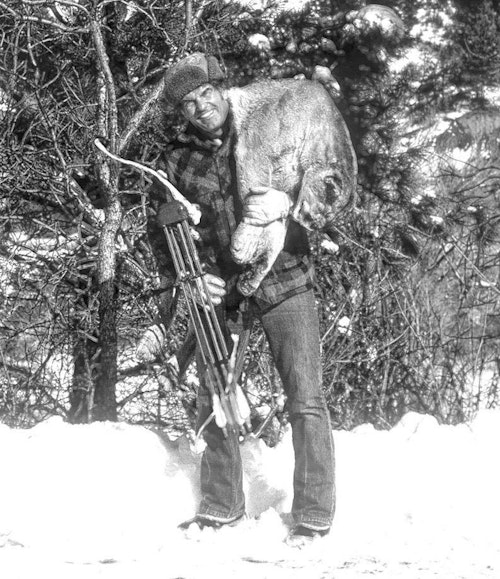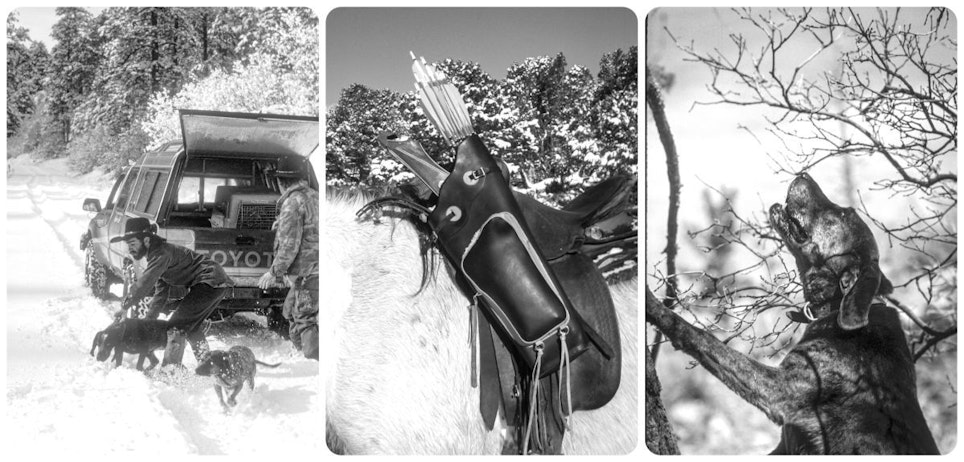Picture the exhilarating adventure of trudging through 3 inches of fresh sparkling snow under clear mountain skies on a crisp, winter morning, listening to the distant bawling of hounds as they work to unravel the twists and turns of a cold cougar trail. The rising fervor in the racketing clamor of the hounds as the pungent scent emanating from the cat’s freshening-tracks increases the dogs’ exuberance. The eventuality of seeing one of North America’s most elusive and reclusive big game animals treed above the baying hounds should be enough incentive to put bowhunting mountain lions near the top of any ardent bowhunter’s bucket-list.
Mountain lion or cougar hunting — regardless of weapon choice — is not generally a do-it-yourself type of big game hunt. And even though there are a few taken each year from blinds or stands by bowhunters, those hunters are primarily after other big game critters. The mountain lion is a master hunter that lives and survives using its superb eyesight combined with its unmatchable patience, stealth and cunning. Getting within bow range of an unaware cougar or mountain lion is simply not in the realm of possibility for most bowhunters.
However, the time has never been better for a bowhunter to tag a trophy mountain lion. The big cat population throughout the West from the Rocky Mountains to the Pacific Ocean is at an all-time high. Additionally, there are more successful guides and outfitters hunting big cats now than ever before. Hiring a guide with a pack of trained cat hounds is the best, and in my experience, the only way for a present day bowhunter to have a reasonable chance to arrow a trophy class big cat for your den — not to mention some fine meat in your freezer. Mountain lion meat is delicious and should never be wasted.
Thriving Cat Populations
The mountain lion population throughout North America is exploding, and in many areas the increase in big cats is having a drastic effect on the deer and other big game populations. For years, Maurice Hornocker’s studies in Idaho showed that mountain lions would kill a deer a week — approximately 50 deer per cat, per year. At the time, the data was taken as gospel by game managers, but times are changing. In California, after a number of years with the big cat classified as a “specially protected mammal,” other studies showed that mountain lions were killing a deer every 1.9 days on average. In many areas of the state, the increasing mountain lion populations have virtually annihilated the mule deer and blacktail deer populations.
In recent years, the proliferation of mountain lions throughout their range has actually increased by guides, outfitters and hound hunters who concentrate on taking only big toms and leaving the females and smaller males to run again. The dominant toms have been proven to be the main killers of cubs and young males. The removal of the mature, dominate males from an area allows the bulk of the younger cats to survive more readily and add to the population increase.
A number of western states have realized the drain on their big game populations by an ever increasing predator population that includes bears, wolves, coyotes and mountain lions, and have begun managing predators more aggressively. Consequently, several states have liberalized their mountain lion seasons and bag limits considerably to bring predation back to a manageable level. This means you, as a present day bowhunter, have never had a better chance to take a trophy mountain lion with bow and arrow, so don’t let the opportunity pass — it may not last.
One and Done?
For most, a mountain lion hunt will probably be an once-in-a-lifetime bowhunt, if successful. Hunts for big cats range from a slam dunk to feverishly frustrating. In a few cases, a hunter and guide “luck out,” locate a fresh track and the dogs actually tree the cat before you get a quarter-mile from the truck. On the other end of the stick, a hunter and guide may locate an old track from a trophy-sized cat only to spend several days cruising canyons and back roads, trying to cut the distance between you and the roaming cat, only to turn the dogs out to no avail … or worse.
Once the dogs are turned out on a lion track, the guide or outfitter no longer has control of the hunt and has to follow it to the end regardless of how tough the going gets or how far the dogs chase the cat. If you as a hunter aren’t in condition enough to cut the mustard and get to the tree at the end of the chase, you’ve cheated yourself, the outfitter and his dogs. As an example, the last cougar I took with a bow took two days to catch up with. On the second day, I had a bug of some kind and was heaving my guts out about every quarter-mile for six hours. I wasn’t sure whether the lion or I was more likely to die that day.
One of the distinct advantages of hunting with hounds that is often overlooked, as well as generally ignored by the anti-hunters, is the “catch and release” aspect of lion hunting. If a lion is treed and isn’t what the bowhunter wants, generally a female or smaller tom, it’s a simple matter to pull the dogs and leave the big cat to run another day, none the worse for wear and a bit smarter for the experience. Of course, there are some bowhunters who think that bowhunting a mountain lion behind a pack of trained hounds is not sporting or exciting. However, every person who has expressed this sentiment to me has never personally been on a hound hunt.
Final Thoughts
If you discuss mountain lion hunting with an outfitter, make sure you to discuss fully your expectations on the quality of animal you will and won’t take, as well as the parameters of your proposed bowhunt from your and the outfitter’s perspectives. If you are looking for a Pope and Young qualifying mountain lion, make sure the outfitter fully understands the ramifications of using electronic collars on his hounds as it applies to your entering a mountain lion in the record books. This nebulous ruling has caused some problems in the past and will probably continue to do so in the near future. If need be, get these understandings in writing before you book a hunt so there are no problems down the road. Be realistic and honest with yourself and the prospective outfitter and you may just experience the hunt of a lifetime.
Sidebar: Record Book Cats
For many years, Colorado was the leader in producing Pope and Young record book mountain lions of the 13 states that presently allow mountain lion hunting. However, according to the latest figures I found, four of the top 10 Pope and Young mountain lions were taken in Idaho, two in Colorado, and one each in Washington, Wyoming, Alberta and British Columbia. Discounting the fact I lived and hunted cats with hounds in Colorado for more than 40 years, my first choice today would be Idaho, followed closely by either Colorado or Montana, and then Utah, New Mexico, Wyoming, Nevada and Arizona. If I were to try calling for mountain lions, I would definitely choose Arizona or West Texas for my bowhunt.
Regardless of your plans, invest in the latest Pope and Young record book and even a Boone and Crockett record book to thoroughly research the best bets for a successful mountain lion bowhunt. The time and effort you spend on thorough research will go a long way toward getting the best bang for your buck and lead to a successful big cat bowhunt.
Photos by Judd Cooney










